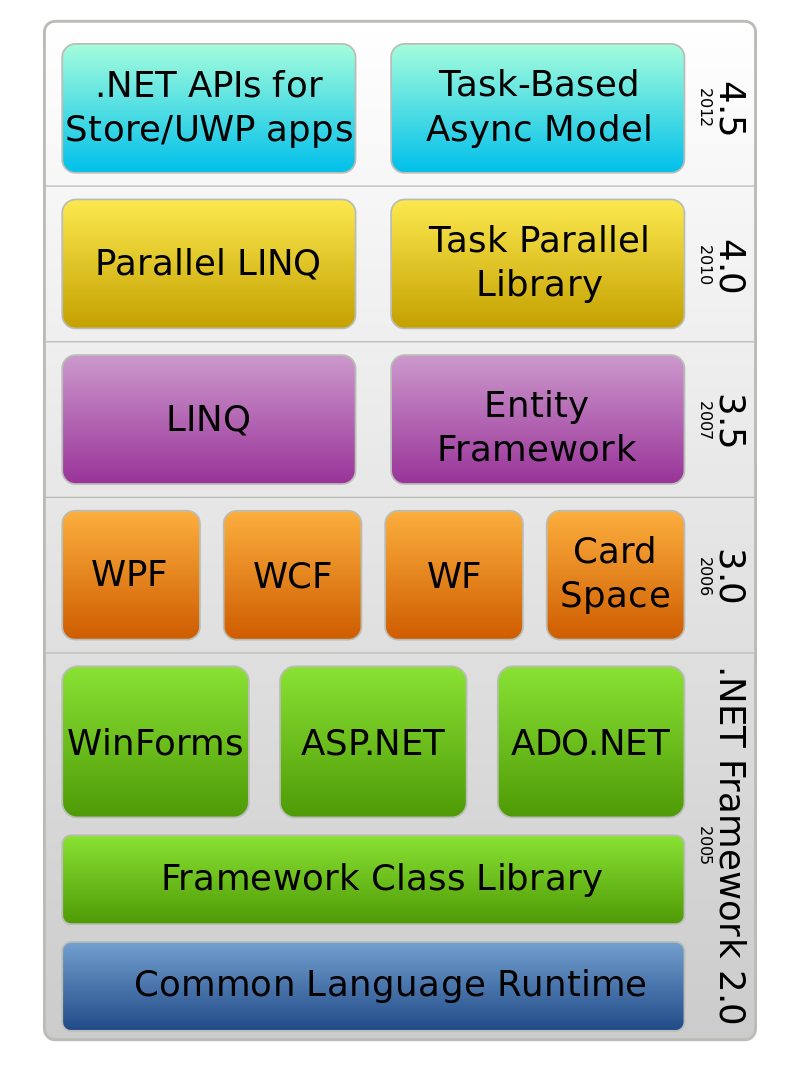.NET | .NET Framework (pronounced dot net) is a software framework developed by Microsoft that runs primarily on Microsoft Windows. It includes a large class library named Framework Class Library (FCL) and provides language interoperability (each language can use code written in other languages) across several programming languages. Programs written for .NET Framework execute in a software environment (in contrast to a hardware environment) named Common Language Runtime (CLR), an application virtual machine that provides services such as security, memory management, and exception handling. (As such, computer code written using .NET Framework is called "managed code".) FCL and CLR together constitute .NET Framework. | ||
100 Mbps—Fast Ethernet | In computer networking, Fast Ethernet physical layers carry traffic at the nominal rate of 100 Mbit/s. The prior Ethernet speed was 10 Mbit/s. Of the Fast Ethernet physical layers, 100BASE-TX is by far the most common. | ||
5ESS | 5ESS Switching System | The 5ESS Switching System is a telephone electronic switching system developed by Western Electric for the American Telephone and Telegraph Company (AT&T) and the Bell System in the United States. | |
5G | 5G is a marketing term for some new mobile technologies. Definitions differ and confusion is common. The ITU IMT-2020 standard provides for speeds up to 20 gigabits per second and has only been demonstrated with millimeter waves of 15 gigahertz and higher frequency. The more recent 3GPP standard includes any network using the NR New Radio software. 5G New Radio can include lower frequencies, from 600 MHz to 6 GHz. However, the speeds in these lower frequencies are only modestly higher than new 4G systems, estimated at 15% to 50% faster. At least at the lower frequencies, "5G is evolutionary." | ||
802.3 Physical Layer | EEE 802.3 is a working group and a collection of Institute of Electrical and Electronics Engineers (IEEE) standards produced by the working group defining the physical layer and data link layer's media access control (MAC) of wired Ethernet. This is generally a local area network (LAN) technology with some wide area network (WAN) applications. Physical connections are made between nodes and/or infrastructure devices (hubs, switches, routers) by various types of copper or fiber cable. | ||
802.11 | EEE 802.11 is part of the IEEE 802 set of local area network (LAN) technical standards, and specifies the set of media access control (MAC) and physical layer (PHY) protocols for implementing wireless local area network (WLAN) computer communication. The standard and amendments provide the basis for wireless network products using the Wi-Fi brand and are the world's most widely used wireless computer networking standards. IEEE 802.11 is used in most home and office networks to allow laptops, printers, smartphones, and other devices to communicate with each other and access the Internet without connecting wires. The standards are created and maintained by the Institute of Electrical and Electronics Engineers (IEEE) LAN/MAN Standards Committee (IEEE 802). The base version of the standard was released in 1997 and has had subsequent amendments. While each amendment is officially revoked when it is incorporated in the latest version of the standard, the corporate world tends to market to the revisions because they concisely denote the capabilities of their products. As a result, in the marketplace, each revision tends to become its own standard. IEEE 802.11 uses various frequencies including, but not limited to, 2.4 GHz, 5 GHz, 6 GHz, and 60 GHz frequency bands. Although IEEE 802.11 specifications list channels that might be used, the radio frequency spectrum availability allowed varies significantly by regulatory domain. The protocols are typically used in conjunction with IEEE 802.2, and are designed to interwork seamlessly with Ethernet, and are very often used to carry Internet Protocol traffic. |
